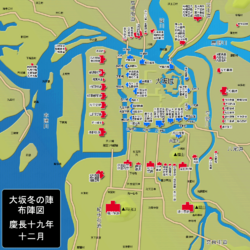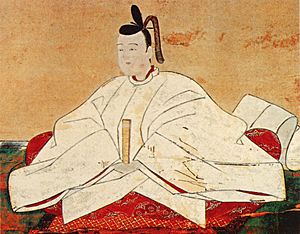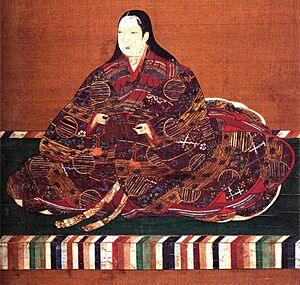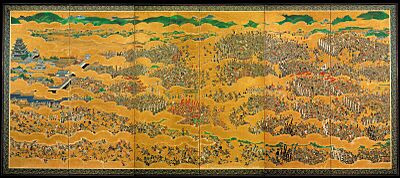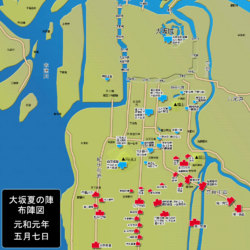Siege of Osaka facts for kids
Quick facts for kids Siege of Osaka |
|||||||
|---|---|---|---|---|---|---|---|
| Part of the late Sengoku Period and the early Edo period | |||||||
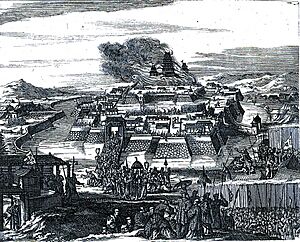 Illustration from François Caron's book: The Burning of Osaka Castle |
|||||||
|
|||||||
| Belligerents | |||||||
|
Tokugawa shogunate and its loyalist banners:
|
Toyotomi clan and its loyalist banners:
|
||||||
| Commanders and leaders | |||||||
| Tokugawa Ieyasu Tokugawa Hidetada Todo Takatora Ii Naotaka Matsudaira Tadanao Date Masamune Honda Masanobu Honda Tadatomo † Satake Yoshinobu Asano Nagaakira Maeda Toshitsune Uesugi Kagekatsu Mōri Hidenari Sanada Nobuyuki Hosokawa Tadaoki Mizuno Katsushige Tachibana Muneshige |
Toyotomi Hideyori † Yodo-dono † Sanada Yukimura † Gotō Mototsugu † Tsutsui Sadatsugu † Akashi Takenori Chōsokabe Morichika Mōri Katsunaga † Fukushima Takaharu Kimura Shigenari † Ōno Harunaga † Sanada Daisuke † Ban Naoyuki † Oda Nobukatsu (defected to Tokugawa side) Hosokawa Okiaki † |
||||||
| Strength | |||||||
| 164,000 (winter) 150,000 (summer) |
120,000 (winter) 60,000 (summer) |
||||||
The Siege of Osaka was a series of big battles in Japan. It happened between the Tokugawa shogunate and the Toyotomi clan. The fighting lasted from 1614 to 1615. It was split into two parts: the winter campaign and the summer campaign. This siege was the last major fight against the Tokugawa shogunate. After it ended, the Tokugawa family ruled Japan for about 250 years.
Contents
How the Conflict Started
After Toyotomi Hideyoshi died in 1598, Japan was ruled by a group of five powerful leaders. Tokugawa Ieyasu was the strongest among them. In 1600, Ieyasu won the Battle of Sekigahara. This victory gave him control over Japan.
In 1603, Ieyasu started the Tokugawa shogunate in Edo (modern-day Tokyo). Hideyoshi's son, Toyotomi Hideyori, and his mother, Yodo-dono, were allowed to stay at Osaka Castle. This castle was Hideyoshi's old home. Hideyori was kept inside the castle for many years. To keep peace, Hideyori married Senhime, who was Ieyasu's granddaughter.
Ieyasu wanted his family to rule Japan strongly and peacefully. The Toyotomi clan, led by Hideyori and influenced by his mother Yodo-dono, was the only group that could challenge him.
In 1611, Hideyori met Ieyasu at Nijō Castle. Ieyasu was surprised because Hideyori seemed smart and capable. Before this, people thought Hideyori was weak. This idea was spread by Katagiri Katsumoto, Hideyori's guardian.
In 1614, the Toyotomi clan rebuilt Osaka Castle. They also helped rebuild a temple in Kyoto called Hōkō-ji. For the temple, they made a huge bronze bell. The bell had words carved into it. These words said, "May the state be peaceful and prosperous" and "May noble lord and servants be rich and cheerful."
The shogunate saw these words as an insult and a threat. They thought the words were a curse on Ieyasu and a sign that the Toyotomi clan planned to rise again. Tensions grew between the two clans. The Toyotomi clan started gathering rōnin (masterless samurai) and other enemies of the shogunate in Osaka. Ieyasu, even though his son was officially the shōgun, still had a lot of power.
Yodo-dono sent people to talk to Ieyasu. Ieyasu tried to cause disagreements among the Toyotomi family. He made generous offers to some and harsh demands to others.
Katagiri Katsumoto tried to make peace. But Ieyasu used the bell incident as an excuse to prepare for war. The situation got worse when news reached Edo that many rōnin were gathering in Osaka. Katsumoto suggested that Yodo-dono go to Edo as a hostage to prevent war. She refused. Yodo-dono then suspected Katsumoto of betrayal and sent him away from Osaka Castle. This ended any chance of peace. The siege of Osaka began soon after.
Preparing for Battle
Hideyori sent letters to many powerful lords in Japan, hoping they would join him. But most of them refused. For example, the Shimazu clan said they were still recovering from a past war. The Ikeda clan even arrested Hideyori's messengers. The Mōri clan decided to support the Tokugawa shogunate instead.
Meanwhile, the shogunate prepared for war by buying weapons. They bought a lot of lead from British and Dutch merchants. William Adams, an English sailor, helped Ieyasu buy cannons, gunpowder, and bullets from British merchants.
Winter Campaign (1614)
In November 1614, Ieyasu decided to act before the Toyotomi forces grew stronger. He led 164,000 soldiers to Osaka. The siege started on November 19. Ieyasu's forces crossed the Kizu River and destroyed a fort.
A week later, they attacked the village of Imafuku. The shogunate forces won with the help of soldiers using arquebuses (early guns). Several small forts and villages were attacked. The main siege of Osaka Castle began on December 4.
The Sanada-maru was a strong outer fort defended by Sanada Yukimura and 7,000 Toyotomi men. The shōgun's armies tried to attack many times but were pushed back. Sanada and his men even launched their own attacks, breaking through the siege lines three times.
Ieyasu then used cannons, including 17 European cannons. His men also dug tunnels under the castle walls. The Tokugawa forces also used Ninja from Iga province and other special fighters.
Bombing Osaka Castle
Ieyasu saw that the castle was very strong. After talking with his advisors, he ordered a limited bombing of the castle. This started on January 8, 1615. For three days, his forces fired cannons at the castle at night and in the morning.
Miners kept digging tunnels under the walls. Soldiers also shot arrows with messages asking the defenders to surrender. By January 15, with no response, Ieyasu started a non-stop bombing. This was mostly to scare the defenders. The castle's stone base was too strong for the cannons of that time, so the main structure was not damaged much.
Ieyasu tried to convince Sanada Yukimura to switch sides. Yukimura strongly disliked Ieyasu and refused the offer. He even told everyone about it. Ieyasu then tried to bribe another commander to open the castle gates. This plan was discovered, and the commander was executed.
Ieyasu changed his plan again. He ordered his men to aim cannons at Yodo-dono's living area. A cannonball hit her quarters, killing two of her maids.
On the night of January 16, a Toyotomi commander named Ban Naotsugu attacked the Tokugawa troops. He killed several enemies before retreating. The bombing continued the next day, which was the anniversary of Toyotomi Hideyoshi's death. Ieyasu thought Hideyori would be at the temple. He ordered his forces to fire there. A cannonball almost hit Hideyori, hitting a pillar in Yodo-dono's room. She became very scared and pushed for a peace agreement.
Peace Talks
On January 17, Ieyasu sent his representatives to meet with Ohatsu, Yodo-dono's younger sister. Ieyasu's representatives said that Ieyasu did not want to harm Hideyori. They said Ieyasu would let Hideyori keep Osaka. If Hideyori wanted to leave, he would get another rich area. All Toyotomi soldiers could leave freely or stay. But Ieyasu wanted some hostages to show good faith.
Ohatsu told Yodo-dono the terms. Yodo-dono was terrified and told Hideyori's advisors to accept the surrender. The two sides met again. They agreed that Ieyasu's men would fill the outer moat of the castle.
On January 21, the Oda family gave their children as hostages. Hideyori sent someone to finalize the agreement. Ieyasu signed a document, even sealing it with his own blood. It said that the rōnin in the castle would not be punished. Hideyori's income would stay the same. Yodo-dono would not have to live in Edo. If Hideyori left Osaka, he could choose any other area. His safety was guaranteed.
On January 22, Hideyori and Yodo-dono promised Ieyasu they would not rebel. Tokugawa soldiers began to tear down the walls and fill the outer moat. Hideyori complained that this was not part of the deal. But the workers said they were just following Ieyasu's orders. Ieyasu's representative blamed the workers for misunderstanding. But soon, the soldiers started filling the inner moat too. Yodo-dono sent a message to Ieyasu in Kyoto. Ieyasu replied that since there was now eternal peace, the walls were not needed.
During these peace talks, Oda Nagamasu, a supporter of Osaka Castle, left and sent his child as a hostage to the Tokugawa. He tried hard to make peace between the two sides. Some records suggest he was working for Ieyasu all along. The Toyotomi clan was divided into three groups:
- One group, led by Ōno Harunaga, wanted peace.
- Another group, led by Kimura Shigenari, was unsure what to do.
- A third group, led by Chōsokabe Morichika, wanted to keep fighting.
Nagamasu left Osaka Castle because he could not keep the peace group strong.
End of the Peace Treaty
Ieyasu left Osaka on January 24. He met with the Emperor and told him the war was over. His son Hidetada stayed to watch the destruction of the castle defenses. But news soon reached the capital that the Toyotomi camp was hiring rōnin again. Because of this, Ieyasu ordered Hideyori to leave Osaka.
Even when peace was being signed, some Toyotomi leaders wanted to attack the Tokugawa camp at night. Hideyori soon learned of Ieyasu's true intentions. So, the Toyotomi began to dig out the moats again and recruit more soldiers. Hideyori and his generals decided to attack first this time. They planned to take over areas around Osaka and capture Kyoto to control the Emperor. This way, the Emperor could declare Ieyasu a rebel. People in Kyoto started to flee because of these rumors.
Ieyasu learned that the Toyotomi had stored rice and were still hiring rōnin. In response, Ieyasu banned ships carrying rice from landing in Osaka. This made food supplies in Osaka scarce. The Toyotomi clan started to argue among themselves about the rōnin. Hideyori was worried about the growing number of rōnin. He gave them gold and silver to keep them from causing trouble, which cost the Toyotomi clan a lot of money.
Hideyori wanted to move from Osaka to another province to get more tax money. Ieyasu agreed to this. But the rōnin threatened to keep fighting Ieyasu even without Hideyori. So, Hideyori changed his mind and decided to fight the shogunate again.
Ieyasu arrived in Kyoto on May 17. He met with Hidetada, who had brought troops ready to go to Osaka.
Summer Campaign (1615)
In April 1615, Ieyasu heard that Toyotomi Hideyori was gathering even more troops. He also heard that Hideyori was trying to refill the castle moats. Toyotomi forces began to attack Tokugawa groups near Osaka.
On May 26, at the Battle of Kashii, Toyotomi forces fought against troops allied with the shōgun. The Toyotomi forces lost many men, and one of their commanders was killed.
On June 2, the Battle of Dōmyōji happened. Toyotomi forces tried to stop the enemy coming from Yamato Province. Two Toyotomi generals were killed. Sanada Yukimura fought against Date Masamune's forces but soon retreated to Osaka Castle. The Tokugawa forces did not chase him.
The same day, other battles took place at Yao and Wakae. In one battle, Toyotomi forces won, but their commander was killed later. The main Tokugawa forces then helped their allies, and the Toyotomi forces pulled back.
Osaka Castle Falls
After more Tokugawa victories outside Osaka, the summer campaign ended with the Battle of Tennōji. Hideyori planned a special attack. His 55,000 men would attack the center of the Tokugawa army. Another group of 16,500 men would attack from behind. Some special ninja units also helped the Tokugawa soldiers attack the castle.
Ieyasu's army, led by his son Tokugawa Hidetada, had about 155,000 soldiers. They moved in four lines, ready to attack from the sides. Mistakes on both sides almost changed the battle's outcome. Hideyori's rōnin separated from the main group. Hidetada's reserve forces moved forward without orders.
In the end, Hideyori's commander, Sanada Yukimura, was killed. This broke the spirit of the Toyotomi Army. Hideyori's smaller force came out of Osaka Castle too late. They were chased back into the castle by the advancing enemies. There was no time to set up a good defense. The castle soon caught fire and was hit by many cannonballs.
People inside the castle started to escape. Hidetada knew his daughter, Senhime, was inside. He sent soldiers to save her. Senhime escaped with Hideyori's son, Toyotomi Kunimatsu, and other women. Kaihime fled with Hideyori's concubine and daughter. Kaihime bravely protected Hideyori's daughter from Tokugawa troops.
Hideyori and Yodo-dono hid in a fireproof building as the castle burned. Ōno Harunaga sent Hideyori's wife, Senhime, to her father Hidetada. She was to ask for forgiveness and beg for her husband's and mother-in-law's lives. Without waiting for an answer, Toyotomi Hideyori and Yodo-dono ended their lives in the burning Osaka Castle. This ended the Toyotomi family line. When their deaths were announced, other loyal followers also ended their lives.
This final major uprising against Tokugawa rule was stopped. The shogunate then ruled Japan without challenge for about 250 years.
What Happened Next
Hideyori's eight-year-old son, Toyotomi Kunimatsu, was captured by Tokugawa forces and executed in Kyoto. Hideyori's daughter, Nāhime, was not killed. Ohatsu and Senhime saved her life and adopted her. She later became a nun at a temple in Kamakura.
Hideyoshi's grave and a shrine dedicated to him in Kyoto were later destroyed by the Tokugawa shogunate. Chōsokabe Morichika was executed on May 11.
The Tokugawa government took control of 650,000 koku (a measure of land value) in Osaka. They started rebuilding Osaka Castle. Osaka became a special area ruled directly by the shogunate, like other major cities in Japan.
The Toyotomi clan was officially ended.
After the castle fell, the shogunate made new laws. One law said that each province could only have one castle. Another law, called Bukeshohatto, limited each powerful lord to one castle. It also said that any castle building or repair needed the shogunate's permission. Many castles were destroyed because of this law.
Even though he had finally united Japan, Ieyasu's health was getting worse. He had been wounded during the year-long campaign against the Toyotomi clan. About a year later, on June 1, 1616, Tokugawa Ieyasu died at age 75. He left the shogunate to his family, who would rule for centuries.
More to Explore
- Winter Campaign (大坂冬の陣 Osaka Fuyu no Jin)
- Battle of Imafuku
- Battle of Shigino
- Battle of Kizugawa
- Battle of Noda-Fukushima
- Siege of Sanada-maru
- Summer Campaign (大坂夏の陣 Osaka Natsu no Jin)
- Battle of Kashii
- Battle of Dōmyōji
- Battle of Yao
- Battle of Wakae
- Battle of Tennoji


